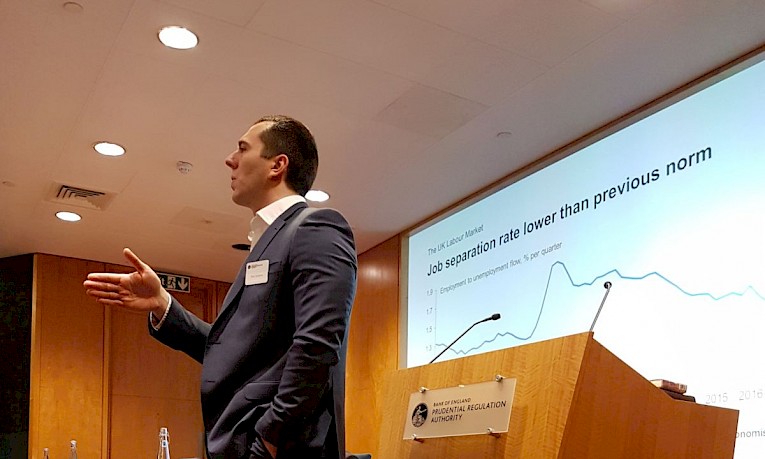15 February 2018
Shaping Monetary Policy at Bank of England
Speaker: Dr Brad Speigner, Bank of England
Venue: Bank of England, Threadneedle Street, London, EC2R 8AH
Summary of SPE Masterclass on How the Bank’s Labour Market Analysis Shape Monetary Policy by Brad Speigner on 15 February 2018
The SPE’s February Masterclass, expertly chaired by Sunil Krishnan, was held at the Bank of England where the Bank’s Brad Speigner provided some fascinating insights into the UK labour market.

Brad began by looking at the Phillips Curve and the original relationship between wage growth and unemployment which, he noted, was clearly non-linear unlike much of the linear analysis of the relationship conducted more recently. An important challenge is to understand why the Phillips Curve appears to have flattened and shifted downwards over very recent years compared with the 2000s. To that end, Brad argues that the unemployment rate may not be the appropriate measure of slack - rather, the under-employment rate (measuring those outside the workforce saying they want a job - also known as ‘marginally attached’) may be more appropriate. He also notes that a period of ‘missing disinflation’ since the 2008 recession might have been caused by a stabilisation of inflation expectations or short-term unemployment becoming a more important indicator.
Brad employs Gordon’s Triangle Model to analyse the relationship between the labour market and inflation. This approach, dating back to the 1970s, models inflation as a function of three things - its past rates (to capture inertia), a measure of the output or unemployment gaps (spare capacity) and supply side controls. One problem is that the equilibrium unemployment rate (or NAIRU) used in calculating the unemployment gap is unobserved and must be estimated (which Brad does via a Kalman Filter, choosing an appropriate amount of smoothing to iron out any sharp quarterly moves). Even with careful estimation, the confidence interval for Brad’s estimate of the NAIRU ranges from 3% to 6% currently. The NAIRU has fallen over time for various reasons including the changing nature of work (eg increased bargaining power), better education and increased contestability.
The model suggests that wage inflation should have risen more sharply during the recovery phase post-crisis. Part of the explanation of why it hasn’t relates to composition. During the recession period the composition effect pushed average pay growth higher as lower productivity people left the workforce first. Since 2014, however, this effect has worked in reverse as lower productivity people have moved back into the employment thereby leading to a large and persistent drag on pay growth.
Brad concludes by analysing pay growth between job switchers and job stayers. This gap has risen - pay growth among switchers (whose proportion has increased) has risen while that of stayers has remained depressed. This so called churn in the labour market affects pay growth both directly - as workers switch into higher paid jobs - and indirectly - as employers pay more to workers if the risk of moving jobs has risen (higher retention pay). In terms of matching workers with jobs, the efficiency with which this is occurring has been declining over time according to a number of studies, a result which holds even if the incidence of long-term unemployment is controlled for. In actual fact, it turns out that low UK unemployment is currently more to do with low rates of job destruction rather than a rise in the pace of job finding.
The SPE would like the thank Brad for his insightful comments and fascinating discussion, and the Bank of England/Prudential Regulation Authority for hosting.
